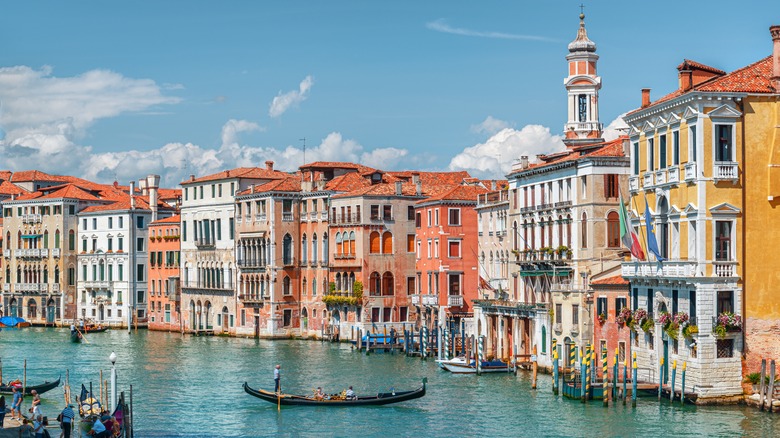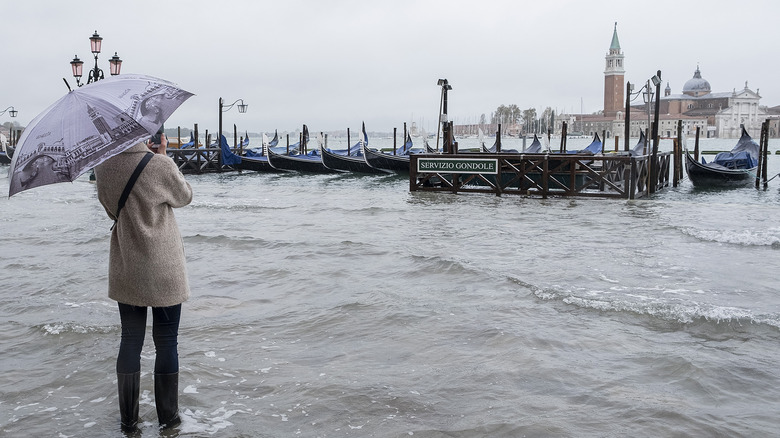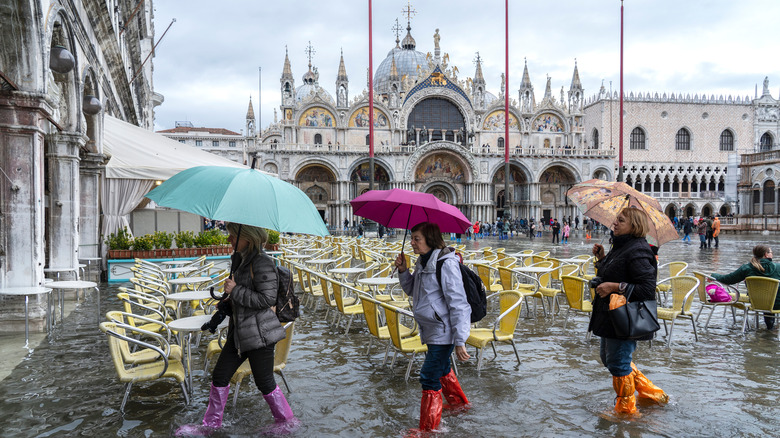The Accommodation Mistake To Avoid While Booking A Place To Stay In Venice, Italy
Venice is one of Europe's most beautiful and atmospheric destinations, but one day this must-visit city for history buffs will be partially underwater. That's not exactly breaking news; the heavily-touristed destination has been fighting for survival against the encroaching lagoon since the 5th century.Now it is estimated that some of its lowest-lying areas, such as the world-famous St. Mark's Square, may be permanently submerged by 2150. It's a tragedy only exacerbated by climate change and rising seas, and that knowledge adds a certain poignancy to your trip as you wander its enchanting canals, streets, and alleyways. On a more selfish level, it also adds another thing to consider when booking a place to stay on the islands of historic Venice: Will your accommodation get flooded?
While thousands of tourists travel across the water each day to experience the romance and sights of the city, there is nothing quite like splurging on somewhere to stay in one of the six historic districts. It gives you more time to explore and also makes it easier to avoid the crowds on your trip to Venice; Rick Steves recommends visiting early or late in the day to beat the crush. One downside of staying on the islands is that you could experience flooding, which is something that has become increasingly common – over half of all the high water events recorded since 1872 have happened in the past three decades. So what causes the flooding, and how can you avoid your trip becoming a total wash out?
What causes flooding in Venice?
For a few months every year, usually between October and December, Venice experiences a natural phenomenon called "acqua alta" (high water). This occurs when sirocco winds blowing up the Adriatic Sea from North Africa encounters high tides and pushes the water ahead of it, causing a surge in the shallow Venetian lagoon. The lagoon is only around 3 feet deep on average and parts of historic Venice can become temporarily flooded. Usually acqua alta only causes the water level to rise by a few inches, but up to 12% of the city is flooded when a tide exceeds 3.5 feet. It is especially a problem in low-lying areas like St. Mark's Square, which sits just 2.5 feet above regular sea level.
Flooding during these months can have a serious impact in a popular destination where the tourist dollar is vital for people's livelihood. In 2019, Venice suffered the highest flood levels since 1966 with water rising by around 6 feet and inundating around 80% of the city. Viral videos circulated showing St. Mark's turned into a pond, people wading through knee-high water, and visitors trudging along makeshift raised walkways. Venetians accept acqua alta as part of normal life, but the worst cases can severely affect businesses. After the 2019 floods, almost half of all hotel booking were canceled. With the city sinking by approximately 0.07 inches each year and sea levels rising by 0.14 inches annually, increased flooding events seem inevitable.
Tips for surviving floods in Venice
While floods during acqua alta usually only last a short while and don't cause a major problem, more dramatic high water events can result in a soggy stay if your accommodation is on the ground floor. While properties in commonly affected areas are often equipped with floodgates, some hotels and apartments in low-lying districts — especially around major landmarks like St. Mark's Square and the Rialto Bridge — are still susceptible to rising tides. Some hotels even provide complimentary rubber boots for their guests.
To avoid the risk of a wash-out, you can download the Hi!Tide app that monitors high tides. If in doubt, check with your hosts in advance to make sure your room or apartment is above ground level. Otherwise you might risk your digs becoming flooded and your belongings floating around the room.
This isn't to say you should avoid Venice during those months. Indeed, it can add a sense of adventure and Rick Steves recommends visiting between November and March to avoid the crowds. Exploring the so-called tourist trap is far more enjoyable without fighting through tourist hordes and, in most cases, flooding won't significantly affect your experience. You won't even need to bring rubber boots if you stick to drier parts of town while acqua alta occurs. In the event of more serious high water levels, don't worry: Venetians are prepared for all but the most disastrous flooding and you can always pick up wet weather gear locally if necessary.


